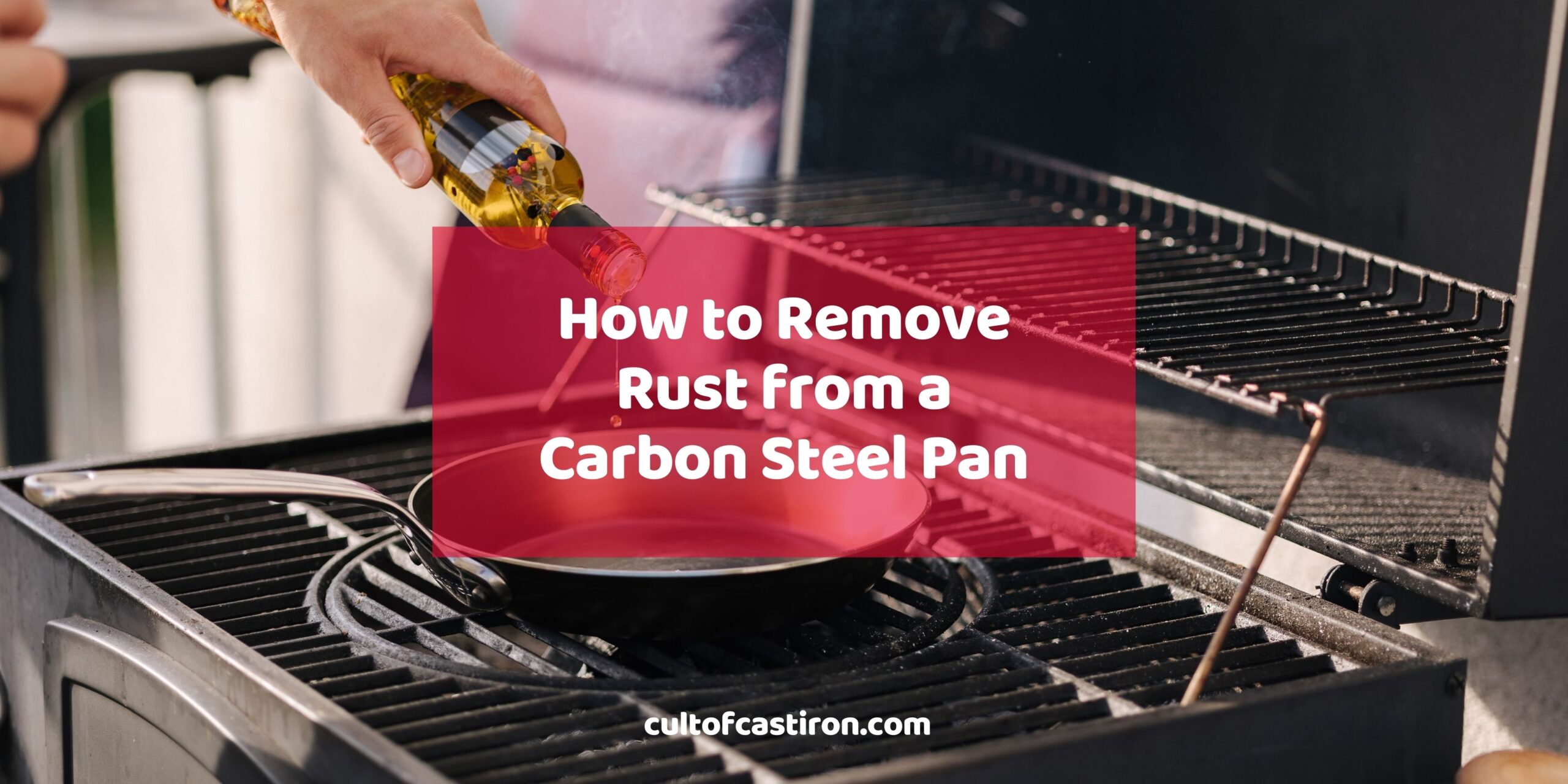Carbon steel pans and woks are cherished by culinary enthusiasts and professional chefs alike for their superior heat conduction and durability. However, despite their robustness, carbon steel cookware is prone to rust if not properly maintained. In a similar case to cast iron, rust formation is a natural reaction of carbon steel to moisture and oxygen, a challenge that can compromise the cookware’s performance and longevity if not addressed promptly. But fear not – this rusting predicament can be easily reversed in a few simple steps!
Keep reading as we take a more in-depth look at how you can remove rust from a carbon steel pan, and how you can prevent it from happening in the future.
Why Does Carbon Steel Rust?
Carbon steel, an alloy of iron and carbon, inherits both the strength of steel and the natural tendency of iron to react with oxygen. This reaction is the fundamental science behind rusting, a form of corrosion that occurs when iron comes into contact with oxygen in the presence of water or moisture in the air. The process, known scientifically as oxidation, results in the formation of iron oxide, commonly referred to as rust.
The susceptibility of carbon steel to rust is primarily due to its iron content. When exposed to the elements, the iron atoms at the surface of the pan or wok react with oxygen molecules to form iron oxide. This reaction is accelerated in environments with high humidity or when the cookware is left wet. The presence of salt, whether from cooking or coastal air, can further expedite the rusting process by lowering the water’s electrochemical potential, making it a more effective electrolyte.
It’s important to note that while rust does not significantly affect the structural integrity of carbon steel cookware in the short term, it can deteriorate the pan’s cooking surface, affecting its non-stick properties and overall cooking performance. That is why addressing it promptly is in your best interest.
How to Fix a Rusty Carbon Steel Pan in 4 Steps
Fixing a rusty carbon steel pan is easier than you think – you’ll only need a few things and a lot of elbow grease to get the job done. Here’s how you can remove rust from your carbon steel pan and restore its sheen.
1. Assessing the Rust
The first step in reviving your carbon steel cookware is to assess the extent of the rust. Let’s categorize these along three levels:
- Light rust – appears as small, superficial orange or brown spots on the surface of the carbon steel. It often looks like a dusting of rust that hasn’t penetrated deeply into the metal. The surface feels slightly rough to the touch, but the rust hasn’t created any significant pits or damage to the cookware.
- Moderate rust – has more pronounced orange to reddish-brown discoloration. It’s more evident and not just limited to spots. The rusted areas feel rougher, and the rust may have started to etch slightly into the metal, though it hasn’t caused significant pitting or structural damage.
- Severe rust – characterized by extensive coverage, with deep, dark rust that may have spread over a large portion of the cookware. It often includes flaking or chipping of the rusted areas. The surface under the rust feels significantly pitted or damaged, indicating that the rust has penetrated deeply into the metal. The integrity of the cookware might be compromised if not addressed.
From there, you can better strategize your method of rust removal.
2. Remove the Rust
Now, it’s time to for the drudgery.
- For light rust, a mixture of warm water and a small amount of dish soap applied with a sponge or nylon brush should be sufficient. Gently scrub the rusted areas until the rust is gone, being careful not to scratch the surface of the pan.
- For moderate rust – Scrub the affected areas with a paste made from baking soda and water. Use a more abrasive tool for this, such as nylon brush or steel wool.
- Severe rust – For pans with extensive rust, soaking the cookware in a mixture of white vinegar and water (equal parts) can be very effective. Leave the pan in the vinegar solution for up to an hour (sometimes, even overnight), then scrub with steel wool or a stiff brush. This acid soak will help loosen and lift the rust, making it easier to remove. This removes most of your seasoning though.
3. Rinsing and Drying
After removing the rust, it’s crucial to thoroughly rinse the pan with clean water to remove any residue from the cleaning agents. Immediately dry the pan with a clean towel to prevent new rust from forming. For added assurance, place the pan on a stove over low heat to evaporate any remaining moisture.
4. Re-seasoning the Pan
Once the pan is dry, it’s time to re-season it to restore its non-stick surface and protect it from future rusting. I’ve written a complete guide to seasoning carbon steel cookware, but if you only want the gist of the process, follow these steps:
- Coat the pan with a high-smoke-point oil. My choice is canola.
- Remove as much of the oil as you can with a clean towel.
- Place the pan upside down in an oven; set the timer to 1 hour.
- Set the temperature based on the oil’s smoke point. For canola oil, it is 255°C (468°F)
- Put another layer of oil on the pan once it has cooled.
After that, you can choose to apply another layer of seasoning on the pan, or put it away for storage, safe in the fact that it is now well-protected against rust.
How to Prevent Rust from Forming on Your Carbon Steel Pan
Maintaining carbon steel cookware involves more than just cleaning it after use; it requires a proactive approach to prevent rust from forming. By following these guidelines, you can ensure your pans remain in excellent condition for years to come.
Don’t soak your carbon steel pan
Soaking carbon steel pans in water is a common mistake that leads to rust formation. Carbon steel is prone to oxidizing when exposed to moisture for extended periods, which makes soaking particularly harmful. Instead of soaking, promptly clean your pan immediately after use, or in my case, right after eating.
Don’t air dry your carbon steel pan
Air drying might seem like a convenient method to dry pans, but it leaves your carbon steel vulnerable to rust. Even small amounts of residual water can start the oxidation process. That’s why it’s crucial to take the additional step of warming your pan on the stove, ensuring it is completely dry.
Choose a better storage space
How and where you store your carbon steel pan can significantly impact its susceptibility to rust. Store your pan in a dry, well-ventilated area to prevent moisture accumulation. If you live in a humid climate or lack ventilation in your storage space, consider using a pan protector or a layer of paper towels inside the pan to absorb any moisture. Hanging your pans can also promote air circulation around them, reducing the risk of rust.
Don’t cook with acidic ingredients
Frequent cooking with acidic ingredients like tomatoes, lemon juice, or vinegar can wear down the seasoning on your pan and expose the bare metal to rust. While occasional use is fine, especially in a well-seasoned pan, it’s advisable to limit the exposure of your carbon steel cookware to acidic foods.
Use wooden or silicone utensils
Metal utensils can scratch the surface of your carbon steel pan, compromising its seasoning and making it more vulnerable to rust. To maintain the integrity of the pan’s seasoned surface, opt for wooden or silicone utensils. These materials are gentle on the pan and prevent the kind of damage that could lead to rust formation.
Conclusion
Your main takeaway from this article may be: if carbon steel is this finicky, then why use it at all?
But as Chuck Palahniuk said: don’t let the things you own end up owning you.
The beauty of carbon steel and cast iron seasoning lies in its ability to be renewed whenever it wears down, in contrast to non-stick pans, which must be discarded as soon as they start to flake. So go ahead, use acidic ingredients (occasionally) and don’t be too much of a perfectionist when it comes to maintaining the seasoning of your carbon steel pan – just don’t forget to re-season afterwards!
If you want to learn more about carbon steel and cast iron cookware, apart from how to store cast iron cookware, go ahead and explore Cult of Cast Iron for more guides and blog articles! Cult of Cast Iron is your ultimate source of information and inspiration for anything and everything cast iron cookware.
Join the Cult of Cast Iron today and discover the wonders of cast iron cookware!

Miguel is a cast iron enthusiast from Cavite, Philippines. He works in the digital marketing field as a content marketing strategist. On the side, he manages a small online bookstore and tends to his plants.

